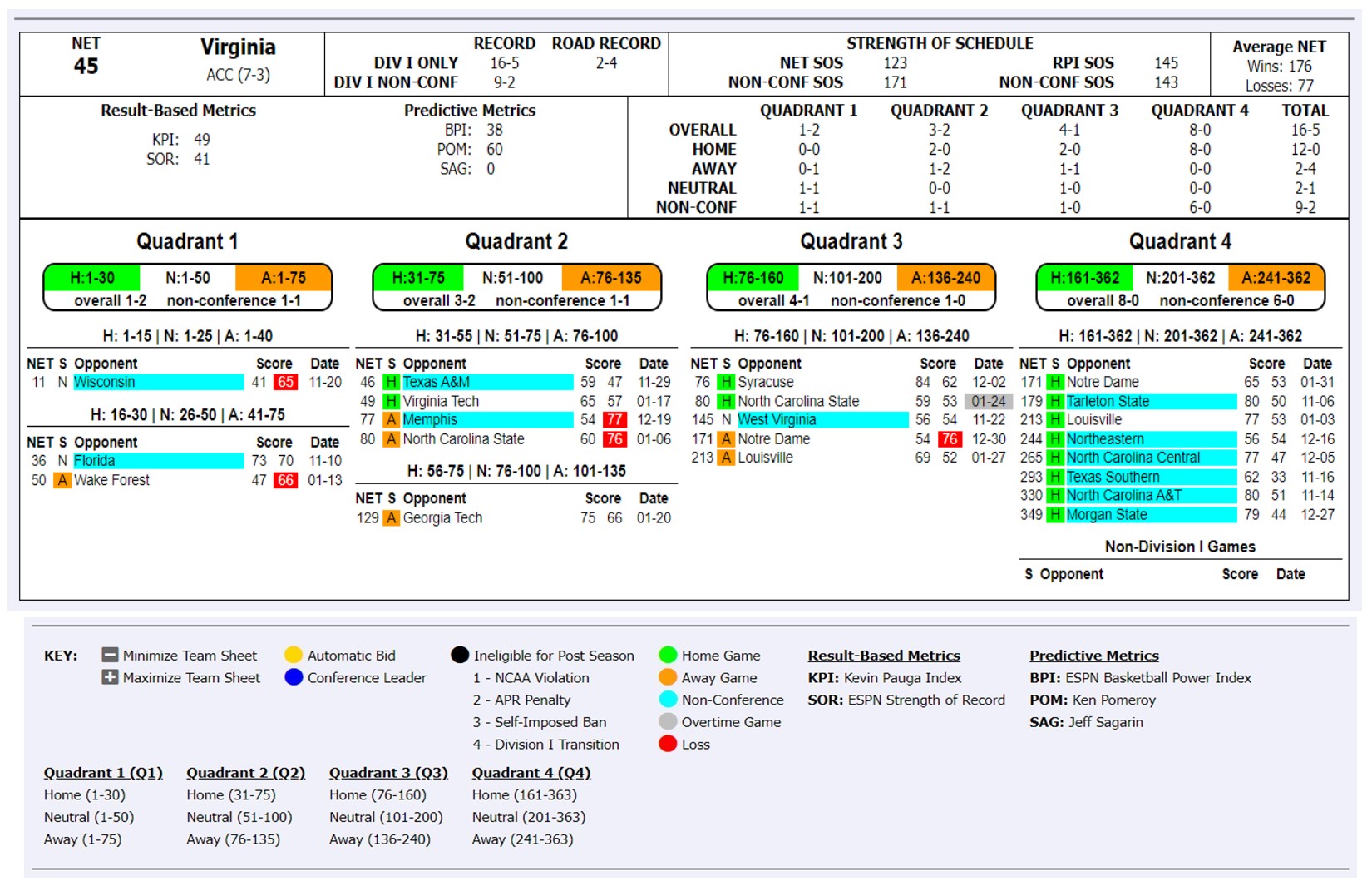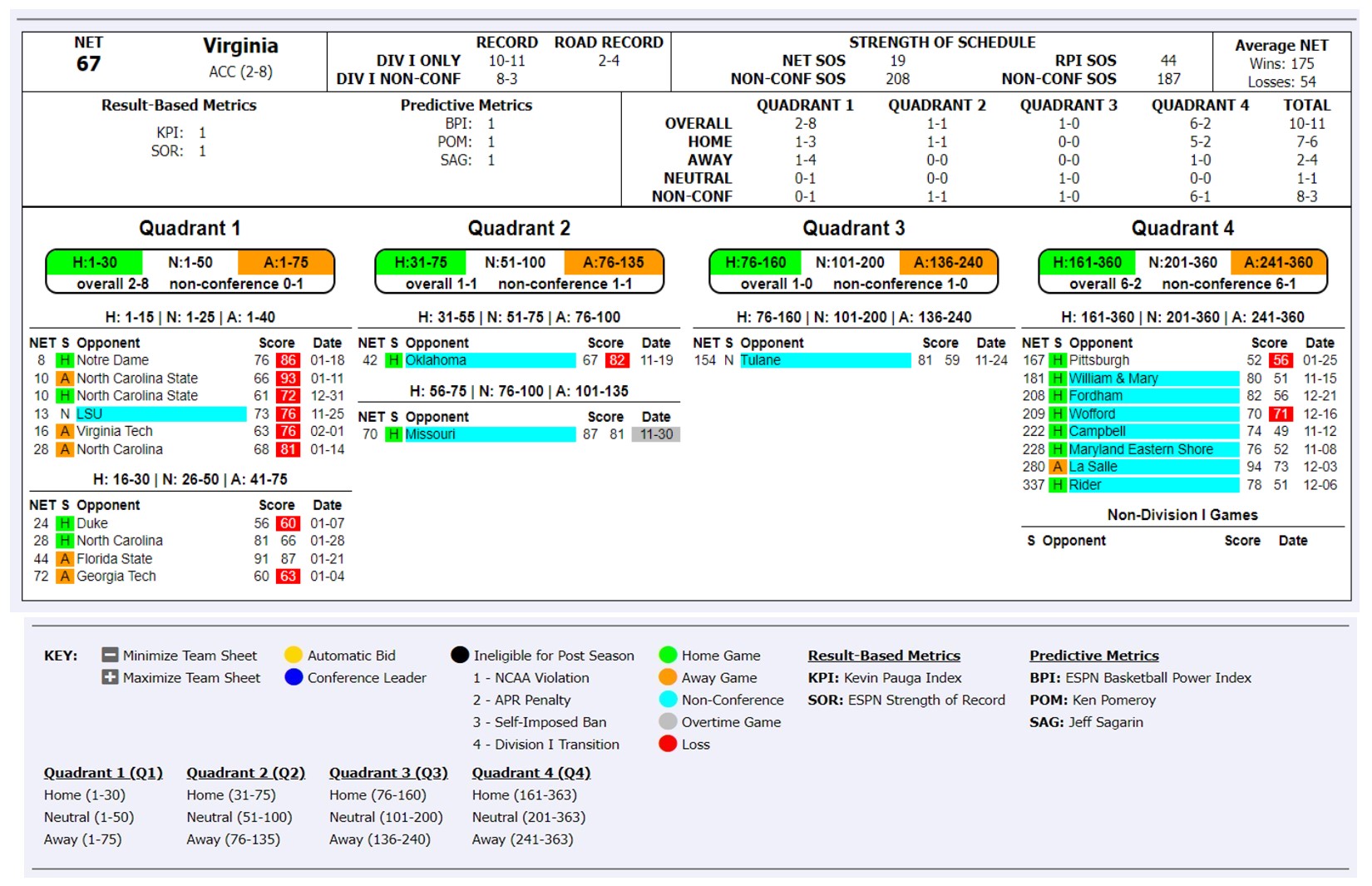Understanding the NET: Where Do Things Stand for Virginia Basketball?

As the calendar ticks into February, and fans and pundits alike start looking ahead to March Madness, we cannot avoid hearing about the NET and discussion of how Quad 1 wins and Quad 4 losses affect our respective teams’ chances for making the NCAA tournaments. So let’s take a deeper look into what the NET actually is because for the last six years it has been the primary tool by which the selection committees sort the 360 teams eligible for March Madness.
The basic premise is that all wins and losses are not equal. The Virginia women’s team just lost to Virginia Tech. Not a big deal, really. They also lost to Pittsburgh, and that could come back to haunt them. On the men’s side, their victory over Florida counts for much more than their victory over Texas A&M.
Why? Well, because of the NET, short for the NCAA Evaluation Tool. The NET attempts to measure the quality of each win and reward teams for quality wins and punish them for inferior losses.
The first thing to know about the NET is that it is a proprietary algorithm owned by the NCAA in conjunction with the folks at Google so our understanding of the NET gets better with the more hindsight we have to apply to it. Invitation to the tournaments is big business and the process is in constant flux. For years the NCAA used the RPI which focused on the strength of schedule of one’s opponents, and then further their opponents’ opponents’ strength of schedule. Since the formulae were in the public domain, they could be gamed and the NCAA has since turned to the NET.
In short, the NET measures the adjusted net efficiency of a team – does it score more points per possession than it surrenders on defense – based on the quality of the opponent and the location of the game. Would you rather beat Duke at Cameron, or at the JPJ? (The NET will reward you more if you beat the Blue Devils in Durham than if you beat them in Charlottesville.)
Margin of victory is no longer part of NET, but in reality, if efficiency is defined as net points per possession, a team will be incentivized to keep starters in longer. Presumably teams will score more with the first string late in the game than with the end of rotation players. As understanding of the NET has increased coaches have learned the benefits of running up the score. Clemson’s Brad Brownell said last year that he kept starters in later in games because he knew his team was on “the bubble.” “I want to make sure the scoring margin stays near 20,” Brownell said. “That’s the first time I’ve ever done that.”
The NCAA waits until mid-December to release their first NET report, and the ratings are updated every day. I presume this is to ensure that there is sufficient data for the initial ranking. Once each team is rated from 1 to 360, then values can be assigned as the worthiness of the games.
The most valuable win is a Quad(rant) 1 win. Quad 1 wins are those which one team plays another that has (a) a top 30 NET if played at home, (b) a top 50 NET if played on a neutral venue, and (c) a top 75 NET rating if played away.
The rest of the breakdown goes as such:
· Quadrant 2: Home 31-75, Neutral 51-100, Away 76-135
· Quadrant 3: Home 76-160, Neutral 101-200, Away 135-240
· Quadrant 4: Home 161-353, Neutral 201-353, Away 241-360
The bottom line: beat good teams (Quad 1) especially on the road and don’t lose to Quad 4 teams anywhere.
Looking at the Virginia men, they currently have a 1 – 2 record in Quad 1. The Cavs played Wisconsin, currently #11 at a neutral site, but lost. They played Wake Forest (#50) away and lost, and they played Florida (#36) at a neutral site and won. Those all fit the definition of Quad 1 games.
Virginia’s other signature win was against Texas A&M at home. Virginia beat the Aggies, but they have a NET rating of 46. That’s a Quad 2 win.
If one half of the NET equation is to beat good teams, the flip side is not to lose to the bad teams, and Virginia is a perfect 8-0 in Quad 4 games. Quad 4 wins don’t move the needle, but those losses hurt. As of Groundhog Day, Virginia was 3-2 in Quad 2 and 4-1 in Quad 3 games. Should the Hoos beat Clemson, in Clemson, that would be a second Quad 1 win since the Tigers sit at #33.
As for the women, they have a 2-8 Quad 1 record. Yeah, the eight losses jump out at you, but Quad 1 losses aren’t a killer. Their Quad 1 wins are against Florida State (#44) away and North Carolina (#28) at home. Here’s where things get interesting. Wins (and losses) don’t stay fixed in a single quadrant, they’re not static. If Carolina falls out of the top 30, then this Quad 1 win is downgraded to a Quad 2. So, for NCAA purposes, Virginia fans should be cheering for UNC to win more games here on out. The NET, like politics, makes for strange bedfellows.
The women are also dragged down by their Quad 4 losses to Pitt (#167) and Wofford (#209). Both are home losses and all home losses to teams below #160 are Quad 4, but should Pitt pick it up a bit and improve to a ranking in the 150s, this will become a Quad 3 loss, and those don’t hurt as much.
Go Panthers!
There are 68 teams invited to the NCAA tournament including the play-in games, so it stands to reason that the women’s competition is going to be found in other teams with NET rankings in the 60s. Of those nine, their average in Quad 1 games is 1-4 while their record in Quad 4 games is 6-0. Those nine had exactly one Quad 4 loss between them, so there are two lessons here. Virginia has played 10 Quad 1 games and one of the hardest schedules in the land. But two Quad 4 losses is huge.
The good news is that all it would take is for Pitt to pick up a single win Quad 1 win of their own for the loss to be upgraded. And the worst loss for the rest of the season could be a Quad 3 loss to Wake Forest (#147 away.)
Here’s what the NET sheets look like for the men (and I apologize if you are reading this on a phone screen, but full season simply cannot be captured on the small screen)

and the women.

Something to Consider
There are a couple of quirks about the NET.
1. The NET is not like any of the rules for determining conference standings. At this point on the men’s side, Pittsburgh sits at #61 in the NET while Syracuse has a 75 rating. Except that Syracuse has beaten Pitt twice. The best way to think of the NET is like the SATs. They are less a measure of past results as an attempt to predict future performance. 20+ games worth of data means more to a Google algorithm than actual head-head results. The issue come March Madness isn’t which team is going win between a ‘Cuse and Pitt match – they’ve already played twice – but which team is going to be more successful against another tournament team.
2. The inherent logic in the NET is circular. Your NET ratings are based on your performances against other team’s NET, which in turn is derived from their opponents’ NET. Programmers call this recursive logic, but in truth, the validity of these rankings is because the NCAA says they have validity.
3. Half of the algorithm that gives us the NET has not been made public. We’re talking the NCAA and Google, two organizations that need more transparency, not less.
4. Running up the score, as already mentioned, is rewarded.
And lastly, #5, wins and losses are counted the same regardless of when they happened which does not take into account injuries, changes in rotation, or the fact that freshmen by February aren’t really freshmen any more. Beating Virginia a month ago, before Jordan Minor was elevated into the starting lineup, was easier than beating Virginia now. Beating Notre Dame before Sonia Citron returned from injury was easier than beating the Fighting Irish now. Player availability matters, and the NET isn’t designed to capture the necessary changes.
Summary
The long and short of it is that there is still a lot of basketball to play and anybody who is worrying about what Joe Lunardi has to say has too much time on their hands. Tony Bennett and his boys and Coach Mox and her charges have ample opportunities to pick up Quad 1 wins and neither team can pick up another Quad 4 loss unless they maybe lose the first game of the ACC tournament. The women, despite a 2-8 ACC record and a pair of Quad 4 losses, are still in the conversation. There’s a lot of basketball left to play, and thanks to the NET, every game matters.
Subscribe to the Cavaliers Now Newsletter to receive UVA sports news in your inbox first thing on Monday, Wednesday, and Friday.
To stay up to date on all Virginia Cavaliers sports news, follow CavaliersNow on social media:
Facebook: @CavaliersNow
Twitter: @CavaliersNowFN
See more Virginia men's basketball news and content: Virginia Men's Basketball on Sports Illustrated
See more Virginia women's basketball news and content: Virginia Women's Basketball on Sports Illustrated
See more Virginia sports news and content: Virginia Cavaliers on Sports Illustrated
